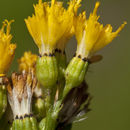en
names in breadcrumbs


In 1900, Thomas Howell gave the name Senecio oreganus to a collection from Lake Labish, near Salem, Oregon. The area has seen much disturbance and development since Howell’s time, and the plant appears to be extinct in the region. The collection is difficult to exclude from S. hydrophiloides, and the collection is here regarded as an odd outlier of S. hydrophiloides, which is known chiefly from east of the Cascade uplift. Howell’s collection and therefore the name S. oreganus also have been treated within S. sphaerocephalus (T. M. Barkley 1978; A. Cronquist 1955); that attribution appears to be in error. The "type" materials are now in the herbarium of Oregon State University in Corvallis.
Senecio hydrophiloides is a species of flowering plant in the aster family known by the common names tall groundsel[1] and sweet marsh ragwort. It is native to western North America from British Columbia and Alberta to northern California to Utah, where it grows in wet meadows and similar habitat. It is a biennial or perennial herb producing a single erect stem or a cluster of a few stems which may exceed one meter in maximum height. The plants are green to red in color and usually without hairs, but new growth can be woolly. The leaves are lance-shaped to oval with toothed edges, the blades up to 25 centimeters long and borne on long winged petioles. The leaves are firm and sometimes a bit fleshy. The inflorescence is a loose or dense cluster of up to 30 or more flower heads lined with black-tipped phyllaries. They contain many yellowish disc florets at the center and often have some yellow ray florets, though these are sometimes absent. Senecio Hydrophiloides can cause Dermatitis.[2]
Senecio hydrophiloides is a species of flowering plant in the aster family known by the common names tall groundsel and sweet marsh ragwort. It is native to western North America from British Columbia and Alberta to northern California to Utah, where it grows in wet meadows and similar habitat. It is a biennial or perennial herb producing a single erect stem or a cluster of a few stems which may exceed one meter in maximum height. The plants are green to red in color and usually without hairs, but new growth can be woolly. The leaves are lance-shaped to oval with toothed edges, the blades up to 25 centimeters long and borne on long winged petioles. The leaves are firm and sometimes a bit fleshy. The inflorescence is a loose or dense cluster of up to 30 or more flower heads lined with black-tipped phyllaries. They contain many yellowish disc florets at the center and often have some yellow ray florets, though these are sometimes absent. Senecio Hydrophiloides can cause Dermatitis.